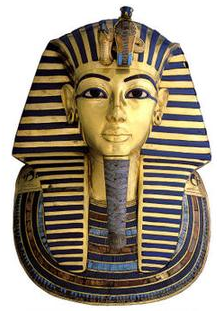YInMn blue
Wednesday 24 August 2016
Colour is an important aspect of chemistry and integrates well with the Group 6 subject Visual Arts. In the 1980s ‘Colour Chemistry’ used to be one of the Options on the now defunct SL Applied Chemistry programme. Rather sadly little emphasis is given to colour in the current 2014 chemistry programme. All that IB Diploma Chemistry students really need to know now is that a particular colour relates to the wavelength of the transmitted light when energy of a certain wavelength in the visible spectrum is absorbed. They are expected to be able to use the colour wheel to determine complementary colours and also be able to explain the spectrochemical series in terms of the splitting of the d orbitals in octahedral transition metal complexes by ligands.
 One of the most interesting colours is the colour blue. Blue is the colour between violet and green on the optical spectrum of visible light. Human eyes perceive blue when observing light with a wavelength between 450 and 495 nanometres. Neolithic cave paintings do not have the colour blue as no stable pigment was known at that time. The first stable blue pigment comes from the semi-precious stone lapis lazuli. This is a complex silicate mineral with the formula (Na,Ca)8(AlSiO4)6(S,SO4,Cl)1-2 which is mainly found in Afghanistan. For a long time this was the only stable blue pigment and was used to colour the eyebrows on the funeral mask of Tutankhamen (left) and in the paintings of Michelangelo during the Renaissance period.
One of the most interesting colours is the colour blue. Blue is the colour between violet and green on the optical spectrum of visible light. Human eyes perceive blue when observing light with a wavelength between 450 and 495 nanometres. Neolithic cave paintings do not have the colour blue as no stable pigment was known at that time. The first stable blue pigment comes from the semi-precious stone lapis lazuli. This is a complex silicate mineral with the formula (Na,Ca)8(AlSiO4)6(S,SO4,Cl)1-2 which is mainly found in Afghanistan. For a long time this was the only stable blue pigment and was used to colour the eyebrows on the funeral mask of Tutankhamen (left) and in the paintings of Michelangelo during the Renaissance period.
Lapis lazuli is expensive but later less costly minerals used to make blue pigments, such as cobalt compounds and Prussian blue, Fe4[Fe(CN)6]3, are toxic so it was not until the discovery of synthetic dyes in the nineteenth century that blue pigments became cheaper and safer to use.
 In 2009 a serendipitous discovery by a graduate student (Andrew Smith) researching under the direction of Professor Mas Subramanian at Oregon State University resulted in a new blue pigment. The vivid blue pigment was formed while manganese oxide was being heated with other elements in a furnace at about 1200 oC in an attempt to create new materials for use in electronics. The blue pigment (see image on right) has been called YInMn blue after its constituent elements.
In 2009 a serendipitous discovery by a graduate student (Andrew Smith) researching under the direction of Professor Mas Subramanian at Oregon State University resulted in a new blue pigment. The vivid blue pigment was formed while manganese oxide was being heated with other elements in a furnace at about 1200 oC in an attempt to create new materials for use in electronics. The blue pigment (see image on right) has been called YInMn blue after its constituent elements.
The pigment is extremely durable. It is stable towards heat and acidic environments and has been shown to reflect infrared light. One possible application of this pigment is to use it to paint roofs to keep homes cooler and thus save energy.
Unlike Prussian blue or cobalt blue, YInMn blue is not toxic, nor is it carcinogenic. This makes it an ideal new blue pigment for artists. Shepherd Color Company has licensed the patent and is already selling the pigment for commercial use and to individual artists.

An image produced by Carol Chapel using YInMn blue

